Effective Communication: Language Use in Workplace, Training Contexts
VerifiedAdded on 2023/06/11
|8
|2120
|394
Essay
AI Summary
This essay explores the crucial role of language in various professional settings, specifically focusing on workplace communication, training programs, and volunteering contexts. It emphasizes the importance of formal language and appropriate communication styles in fostering effective interactions and maintaining a professional environment. The analysis covers different modes of communication, including verbal (in-person) communication, body language, phone conversations, and written communication, highlighting the advantages and disadvantages of each. The essay also addresses the complexities of language diversity in the workplace, discussing the debate around using native languages versus a universal language like English. Ultimately, it concludes that organizations benefit from adopting a formal and universal language to enhance communication, promote clarity, and avoid misunderstandings, which are vital for overall success and a positive work environment. The essay further references various resources that support the claim of using formal language in the workplace.
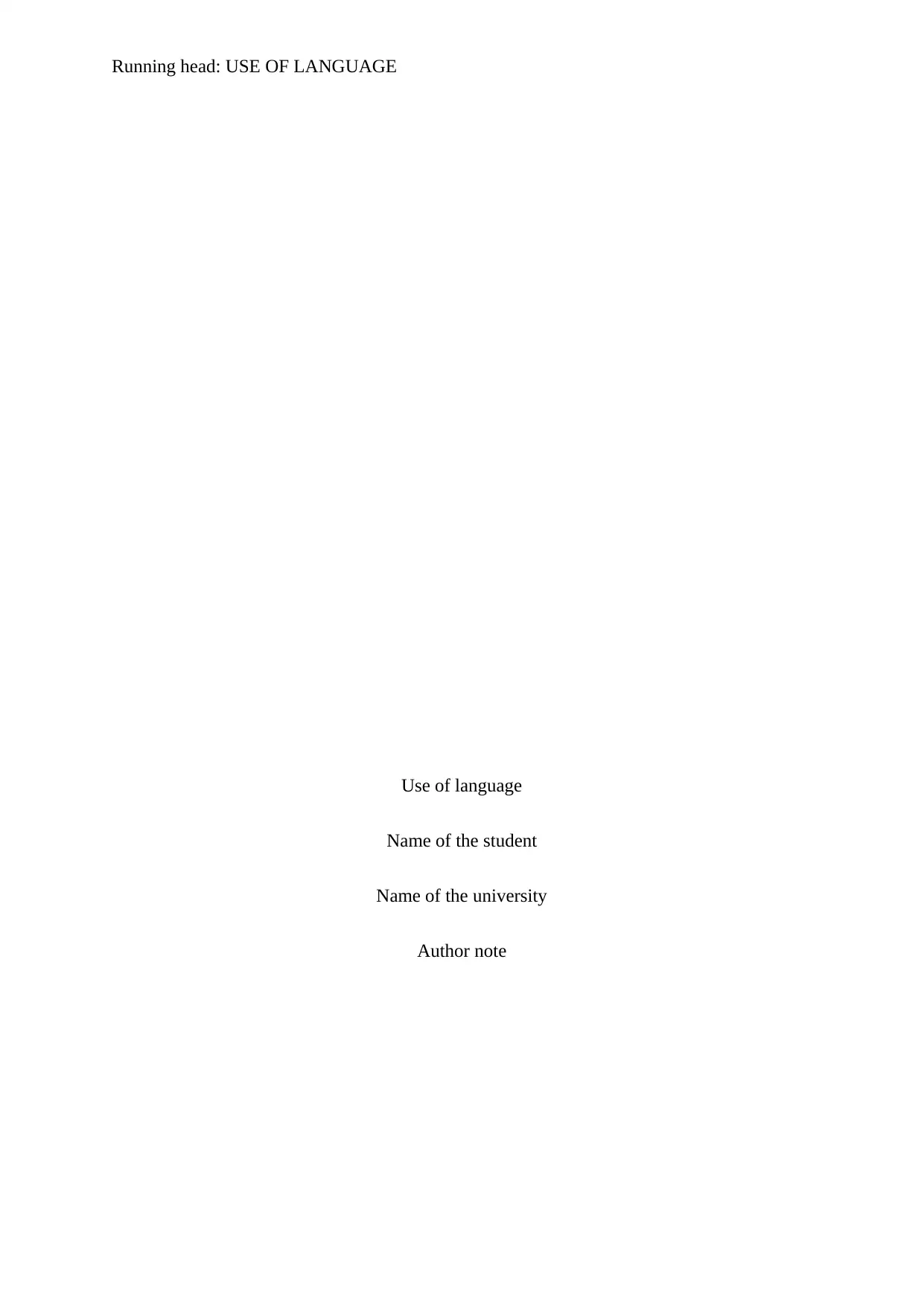
Running head: USE OF LANGUAGE
Use of language
Name of the student
Name of the university
Author note
Use of language
Name of the student
Name of the university
Author note
Paraphrase This Document
Need a fresh take? Get an instant paraphrase of this document with our AI Paraphraser
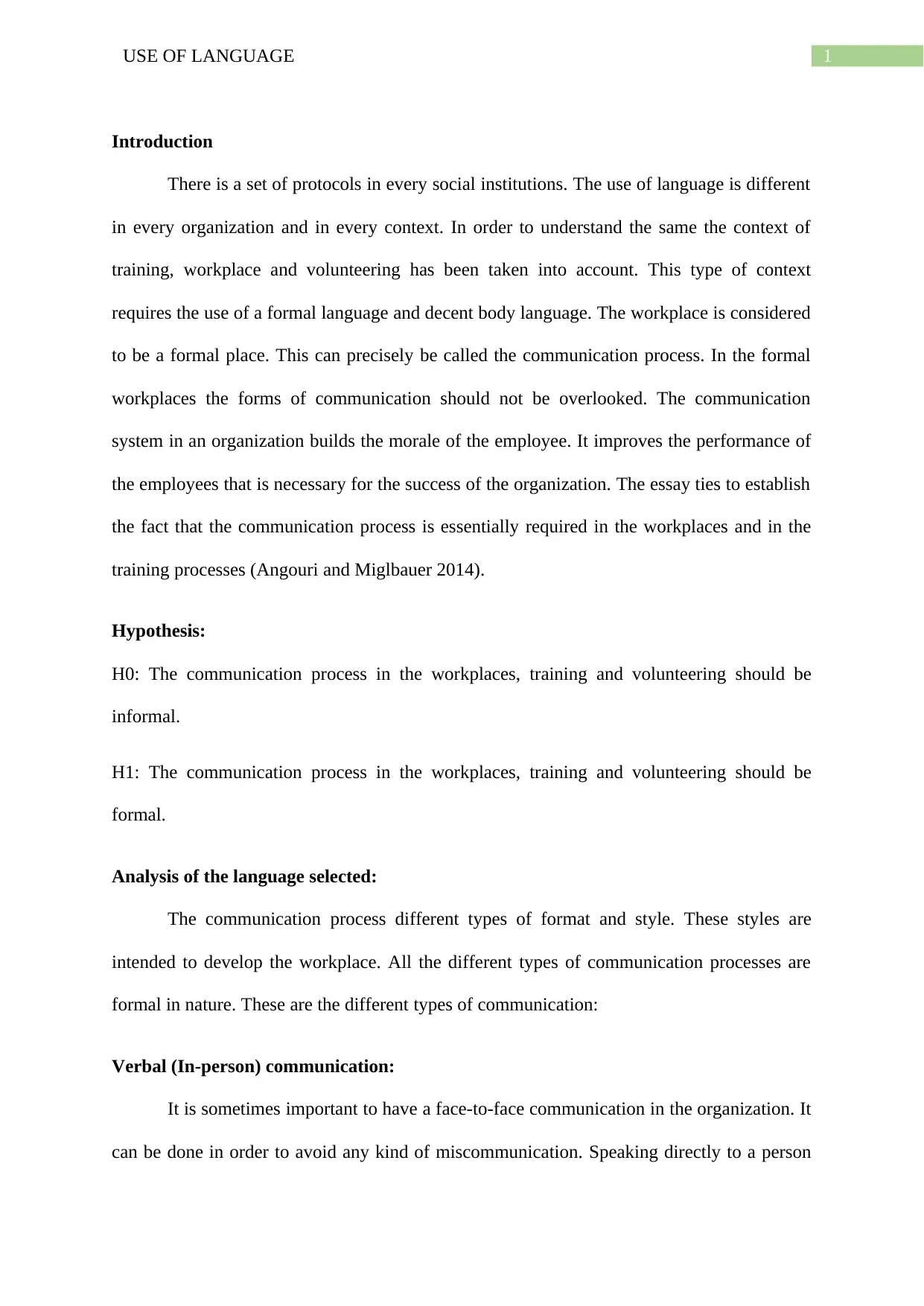
1USE OF LANGUAGE
Introduction
There is a set of protocols in every social institutions. The use of language is different
in every organization and in every context. In order to understand the same the context of
training, workplace and volunteering has been taken into account. This type of context
requires the use of a formal language and decent body language. The workplace is considered
to be a formal place. This can precisely be called the communication process. In the formal
workplaces the forms of communication should not be overlooked. The communication
system in an organization builds the morale of the employee. It improves the performance of
the employees that is necessary for the success of the organization. The essay ties to establish
the fact that the communication process is essentially required in the workplaces and in the
training processes (Angouri and Miglbauer 2014).
Hypothesis:
H0: The communication process in the workplaces, training and volunteering should be
informal.
H1: The communication process in the workplaces, training and volunteering should be
formal.
Analysis of the language selected:
The communication process different types of format and style. These styles are
intended to develop the workplace. All the different types of communication processes are
formal in nature. These are the different types of communication:
Verbal (In-person) communication:
It is sometimes important to have a face-to-face communication in the organization. It
can be done in order to avoid any kind of miscommunication. Speaking directly to a person
Introduction
There is a set of protocols in every social institutions. The use of language is different
in every organization and in every context. In order to understand the same the context of
training, workplace and volunteering has been taken into account. This type of context
requires the use of a formal language and decent body language. The workplace is considered
to be a formal place. This can precisely be called the communication process. In the formal
workplaces the forms of communication should not be overlooked. The communication
system in an organization builds the morale of the employee. It improves the performance of
the employees that is necessary for the success of the organization. The essay ties to establish
the fact that the communication process is essentially required in the workplaces and in the
training processes (Angouri and Miglbauer 2014).
Hypothesis:
H0: The communication process in the workplaces, training and volunteering should be
informal.
H1: The communication process in the workplaces, training and volunteering should be
formal.
Analysis of the language selected:
The communication process different types of format and style. These styles are
intended to develop the workplace. All the different types of communication processes are
formal in nature. These are the different types of communication:
Verbal (In-person) communication:
It is sometimes important to have a face-to-face communication in the organization. It
can be done in order to avoid any kind of miscommunication. Speaking directly to a person
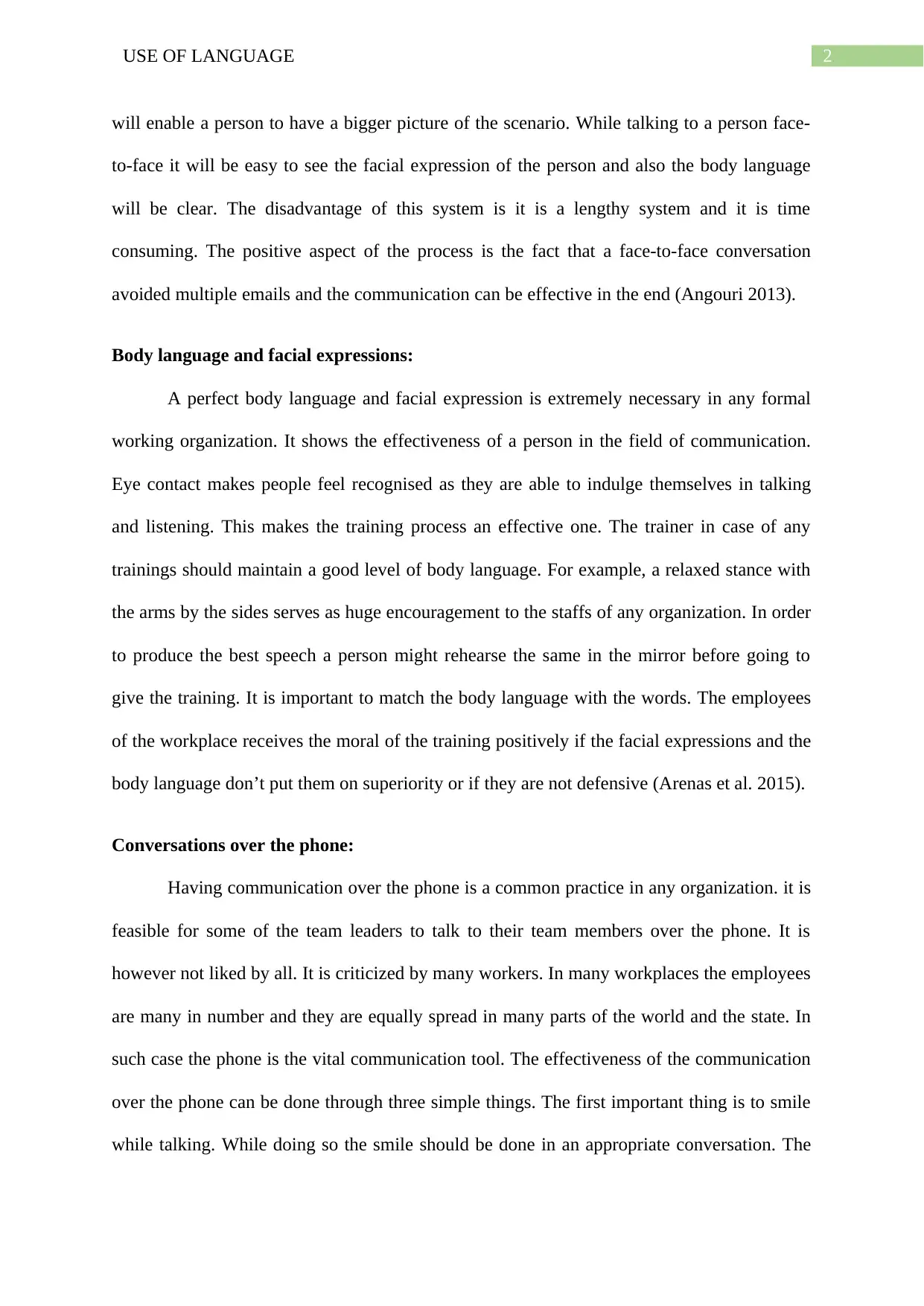
2USE OF LANGUAGE
will enable a person to have a bigger picture of the scenario. While talking to a person face-
to-face it will be easy to see the facial expression of the person and also the body language
will be clear. The disadvantage of this system is it is a lengthy system and it is time
consuming. The positive aspect of the process is the fact that a face-to-face conversation
avoided multiple emails and the communication can be effective in the end (Angouri 2013).
Body language and facial expressions:
A perfect body language and facial expression is extremely necessary in any formal
working organization. It shows the effectiveness of a person in the field of communication.
Eye contact makes people feel recognised as they are able to indulge themselves in talking
and listening. This makes the training process an effective one. The trainer in case of any
trainings should maintain a good level of body language. For example, a relaxed stance with
the arms by the sides serves as huge encouragement to the staffs of any organization. In order
to produce the best speech a person might rehearse the same in the mirror before going to
give the training. It is important to match the body language with the words. The employees
of the workplace receives the moral of the training positively if the facial expressions and the
body language don’t put them on superiority or if they are not defensive (Arenas et al. 2015).
Conversations over the phone:
Having communication over the phone is a common practice in any organization. it is
feasible for some of the team leaders to talk to their team members over the phone. It is
however not liked by all. It is criticized by many workers. In many workplaces the employees
are many in number and they are equally spread in many parts of the world and the state. In
such case the phone is the vital communication tool. The effectiveness of the communication
over the phone can be done through three simple things. The first important thing is to smile
while talking. While doing so the smile should be done in an appropriate conversation. The
will enable a person to have a bigger picture of the scenario. While talking to a person face-
to-face it will be easy to see the facial expression of the person and also the body language
will be clear. The disadvantage of this system is it is a lengthy system and it is time
consuming. The positive aspect of the process is the fact that a face-to-face conversation
avoided multiple emails and the communication can be effective in the end (Angouri 2013).
Body language and facial expressions:
A perfect body language and facial expression is extremely necessary in any formal
working organization. It shows the effectiveness of a person in the field of communication.
Eye contact makes people feel recognised as they are able to indulge themselves in talking
and listening. This makes the training process an effective one. The trainer in case of any
trainings should maintain a good level of body language. For example, a relaxed stance with
the arms by the sides serves as huge encouragement to the staffs of any organization. In order
to produce the best speech a person might rehearse the same in the mirror before going to
give the training. It is important to match the body language with the words. The employees
of the workplace receives the moral of the training positively if the facial expressions and the
body language don’t put them on superiority or if they are not defensive (Arenas et al. 2015).
Conversations over the phone:
Having communication over the phone is a common practice in any organization. it is
feasible for some of the team leaders to talk to their team members over the phone. It is
however not liked by all. It is criticized by many workers. In many workplaces the employees
are many in number and they are equally spread in many parts of the world and the state. In
such case the phone is the vital communication tool. The effectiveness of the communication
over the phone can be done through three simple things. The first important thing is to smile
while talking. While doing so the smile should be done in an appropriate conversation. The
⊘ This is a preview!⊘
Do you want full access?
Subscribe today to unlock all pages.

Trusted by 1+ million students worldwide
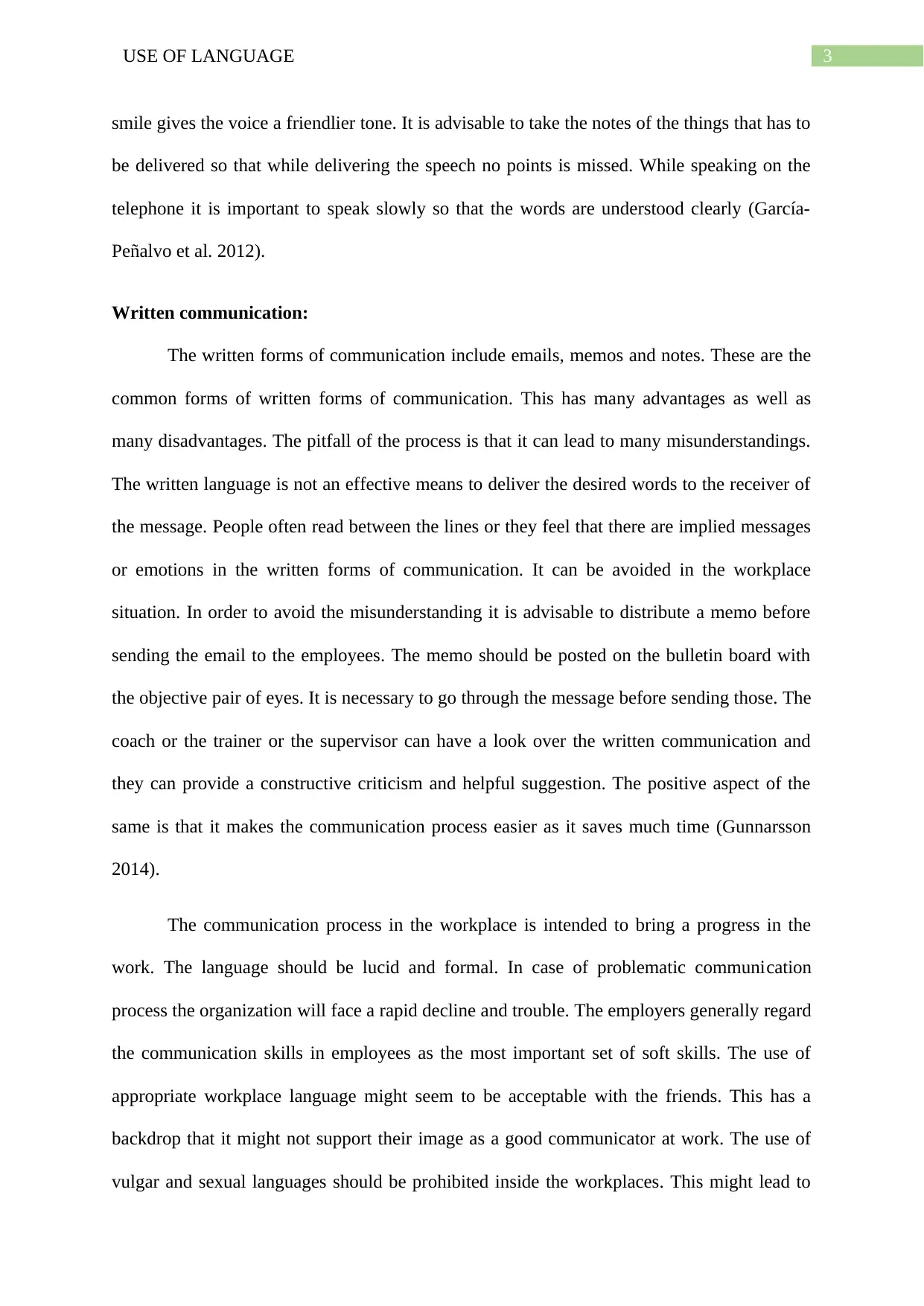
3USE OF LANGUAGE
smile gives the voice a friendlier tone. It is advisable to take the notes of the things that has to
be delivered so that while delivering the speech no points is missed. While speaking on the
telephone it is important to speak slowly so that the words are understood clearly (García-
Peñalvo et al. 2012).
Written communication:
The written forms of communication include emails, memos and notes. These are the
common forms of written forms of communication. This has many advantages as well as
many disadvantages. The pitfall of the process is that it can lead to many misunderstandings.
The written language is not an effective means to deliver the desired words to the receiver of
the message. People often read between the lines or they feel that there are implied messages
or emotions in the written forms of communication. It can be avoided in the workplace
situation. In order to avoid the misunderstanding it is advisable to distribute a memo before
sending the email to the employees. The memo should be posted on the bulletin board with
the objective pair of eyes. It is necessary to go through the message before sending those. The
coach or the trainer or the supervisor can have a look over the written communication and
they can provide a constructive criticism and helpful suggestion. The positive aspect of the
same is that it makes the communication process easier as it saves much time (Gunnarsson
2014).
The communication process in the workplace is intended to bring a progress in the
work. The language should be lucid and formal. In case of problematic communication
process the organization will face a rapid decline and trouble. The employers generally regard
the communication skills in employees as the most important set of soft skills. The use of
appropriate workplace language might seem to be acceptable with the friends. This has a
backdrop that it might not support their image as a good communicator at work. The use of
vulgar and sexual languages should be prohibited inside the workplaces. This might lead to
smile gives the voice a friendlier tone. It is advisable to take the notes of the things that has to
be delivered so that while delivering the speech no points is missed. While speaking on the
telephone it is important to speak slowly so that the words are understood clearly (García-
Peñalvo et al. 2012).
Written communication:
The written forms of communication include emails, memos and notes. These are the
common forms of written forms of communication. This has many advantages as well as
many disadvantages. The pitfall of the process is that it can lead to many misunderstandings.
The written language is not an effective means to deliver the desired words to the receiver of
the message. People often read between the lines or they feel that there are implied messages
or emotions in the written forms of communication. It can be avoided in the workplace
situation. In order to avoid the misunderstanding it is advisable to distribute a memo before
sending the email to the employees. The memo should be posted on the bulletin board with
the objective pair of eyes. It is necessary to go through the message before sending those. The
coach or the trainer or the supervisor can have a look over the written communication and
they can provide a constructive criticism and helpful suggestion. The positive aspect of the
same is that it makes the communication process easier as it saves much time (Gunnarsson
2014).
The communication process in the workplace is intended to bring a progress in the
work. The language should be lucid and formal. In case of problematic communication
process the organization will face a rapid decline and trouble. The employers generally regard
the communication skills in employees as the most important set of soft skills. The use of
appropriate workplace language might seem to be acceptable with the friends. This has a
backdrop that it might not support their image as a good communicator at work. The use of
vulgar and sexual languages should be prohibited inside the workplaces. This might lead to
Paraphrase This Document
Need a fresh take? Get an instant paraphrase of this document with our AI Paraphraser
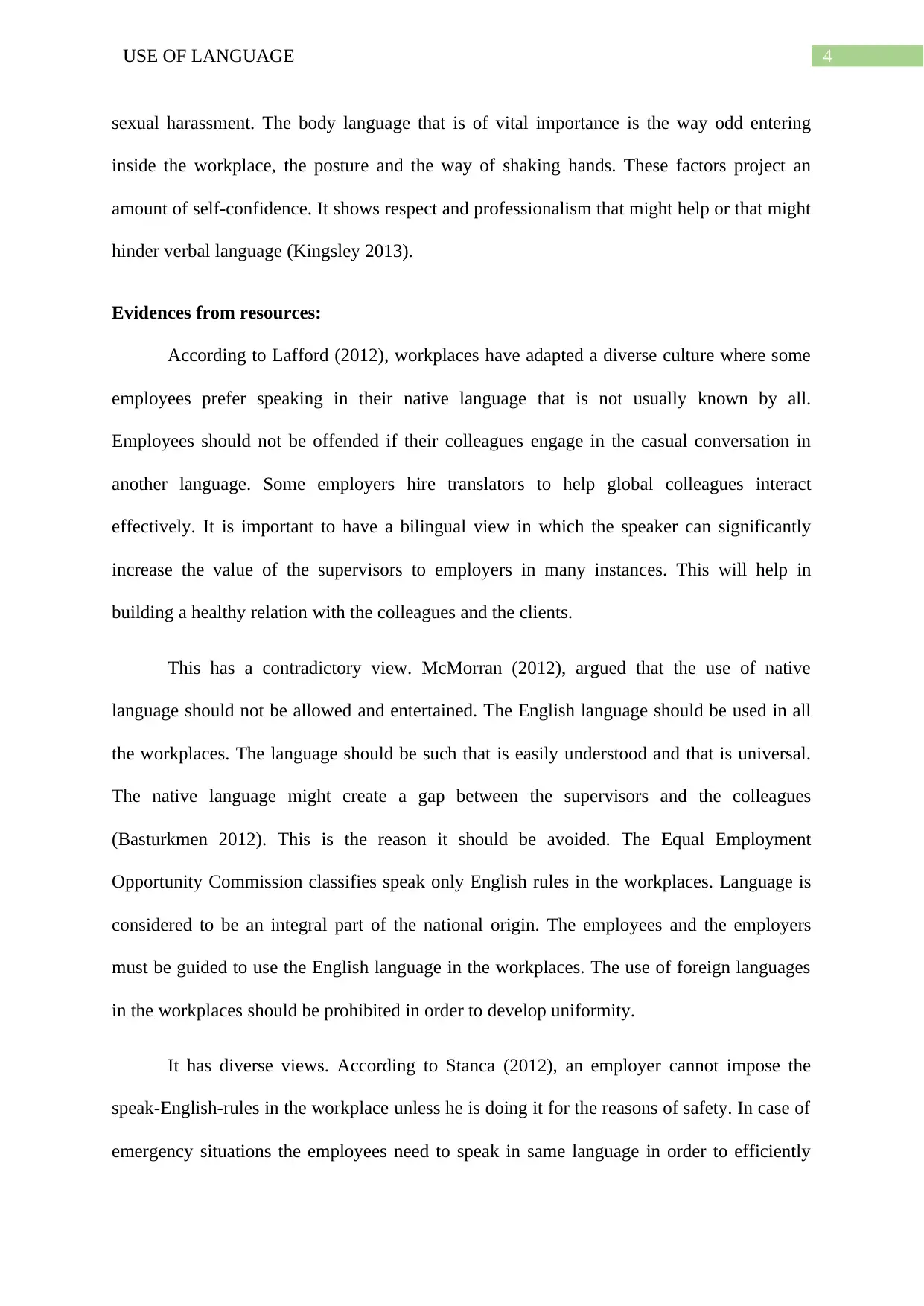
4USE OF LANGUAGE
sexual harassment. The body language that is of vital importance is the way odd entering
inside the workplace, the posture and the way of shaking hands. These factors project an
amount of self-confidence. It shows respect and professionalism that might help or that might
hinder verbal language (Kingsley 2013).
Evidences from resources:
According to Lafford (2012), workplaces have adapted a diverse culture where some
employees prefer speaking in their native language that is not usually known by all.
Employees should not be offended if their colleagues engage in the casual conversation in
another language. Some employers hire translators to help global colleagues interact
effectively. It is important to have a bilingual view in which the speaker can significantly
increase the value of the supervisors to employers in many instances. This will help in
building a healthy relation with the colleagues and the clients.
This has a contradictory view. McMorran (2012), argued that the use of native
language should not be allowed and entertained. The English language should be used in all
the workplaces. The language should be such that is easily understood and that is universal.
The native language might create a gap between the supervisors and the colleagues
(Basturkmen 2012). This is the reason it should be avoided. The Equal Employment
Opportunity Commission classifies speak only English rules in the workplaces. Language is
considered to be an integral part of the national origin. The employees and the employers
must be guided to use the English language in the workplaces. The use of foreign languages
in the workplaces should be prohibited in order to develop uniformity.
It has diverse views. According to Stanca (2012), an employer cannot impose the
speak-English-rules in the workplace unless he is doing it for the reasons of safety. In case of
emergency situations the employees need to speak in same language in order to efficiently
sexual harassment. The body language that is of vital importance is the way odd entering
inside the workplace, the posture and the way of shaking hands. These factors project an
amount of self-confidence. It shows respect and professionalism that might help or that might
hinder verbal language (Kingsley 2013).
Evidences from resources:
According to Lafford (2012), workplaces have adapted a diverse culture where some
employees prefer speaking in their native language that is not usually known by all.
Employees should not be offended if their colleagues engage in the casual conversation in
another language. Some employers hire translators to help global colleagues interact
effectively. It is important to have a bilingual view in which the speaker can significantly
increase the value of the supervisors to employers in many instances. This will help in
building a healthy relation with the colleagues and the clients.
This has a contradictory view. McMorran (2012), argued that the use of native
language should not be allowed and entertained. The English language should be used in all
the workplaces. The language should be such that is easily understood and that is universal.
The native language might create a gap between the supervisors and the colleagues
(Basturkmen 2012). This is the reason it should be avoided. The Equal Employment
Opportunity Commission classifies speak only English rules in the workplaces. Language is
considered to be an integral part of the national origin. The employees and the employers
must be guided to use the English language in the workplaces. The use of foreign languages
in the workplaces should be prohibited in order to develop uniformity.
It has diverse views. According to Stanca (2012), an employer cannot impose the
speak-English-rules in the workplace unless he is doing it for the reasons of safety. In case of
emergency situations the employees need to speak in same language in order to efficiently
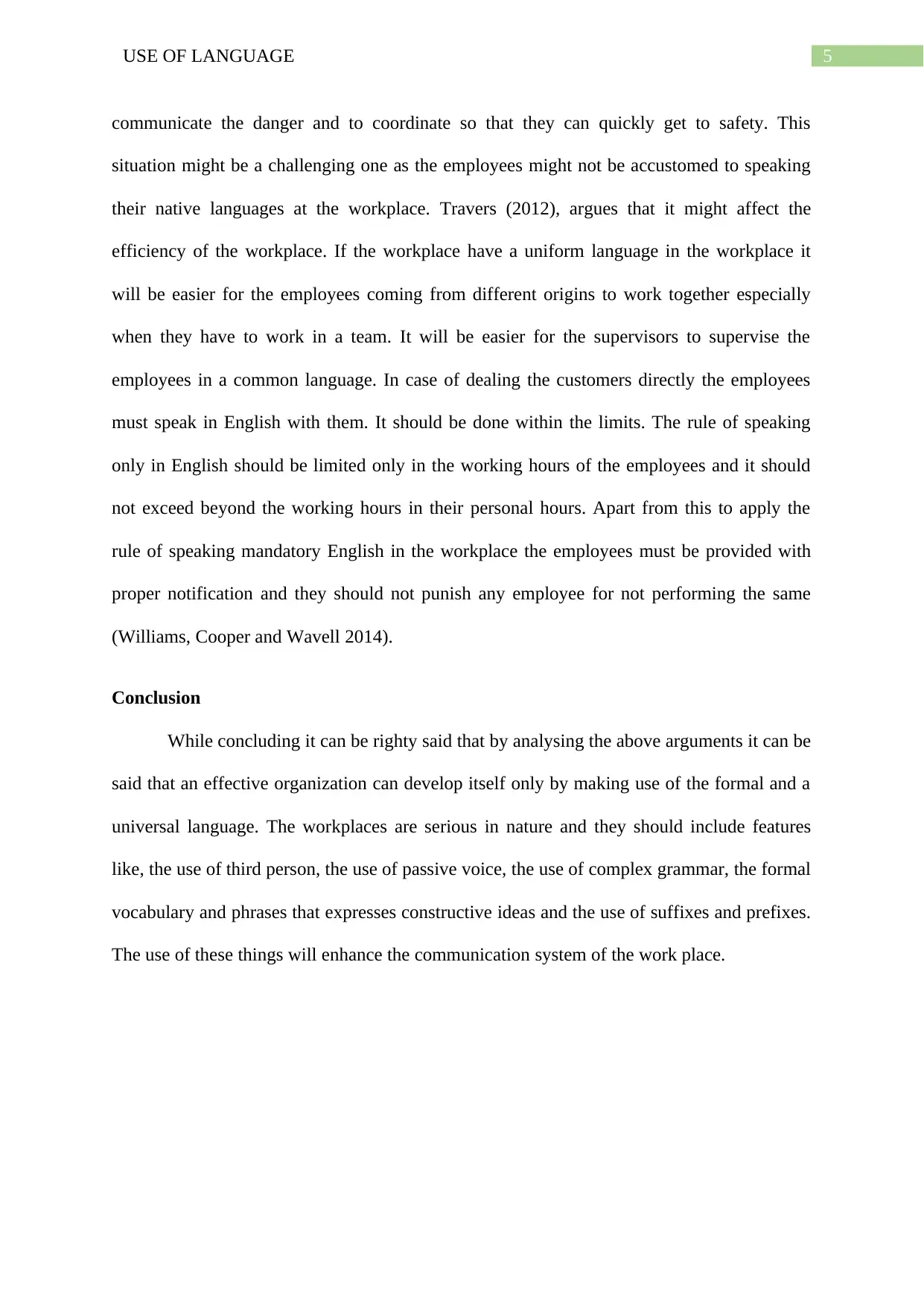
5USE OF LANGUAGE
communicate the danger and to coordinate so that they can quickly get to safety. This
situation might be a challenging one as the employees might not be accustomed to speaking
their native languages at the workplace. Travers (2012), argues that it might affect the
efficiency of the workplace. If the workplace have a uniform language in the workplace it
will be easier for the employees coming from different origins to work together especially
when they have to work in a team. It will be easier for the supervisors to supervise the
employees in a common language. In case of dealing the customers directly the employees
must speak in English with them. It should be done within the limits. The rule of speaking
only in English should be limited only in the working hours of the employees and it should
not exceed beyond the working hours in their personal hours. Apart from this to apply the
rule of speaking mandatory English in the workplace the employees must be provided with
proper notification and they should not punish any employee for not performing the same
(Williams, Cooper and Wavell 2014).
Conclusion
While concluding it can be righty said that by analysing the above arguments it can be
said that an effective organization can develop itself only by making use of the formal and a
universal language. The workplaces are serious in nature and they should include features
like, the use of third person, the use of passive voice, the use of complex grammar, the formal
vocabulary and phrases that expresses constructive ideas and the use of suffixes and prefixes.
The use of these things will enhance the communication system of the work place.
communicate the danger and to coordinate so that they can quickly get to safety. This
situation might be a challenging one as the employees might not be accustomed to speaking
their native languages at the workplace. Travers (2012), argues that it might affect the
efficiency of the workplace. If the workplace have a uniform language in the workplace it
will be easier for the employees coming from different origins to work together especially
when they have to work in a team. It will be easier for the supervisors to supervise the
employees in a common language. In case of dealing the customers directly the employees
must speak in English with them. It should be done within the limits. The rule of speaking
only in English should be limited only in the working hours of the employees and it should
not exceed beyond the working hours in their personal hours. Apart from this to apply the
rule of speaking mandatory English in the workplace the employees must be provided with
proper notification and they should not punish any employee for not performing the same
(Williams, Cooper and Wavell 2014).
Conclusion
While concluding it can be righty said that by analysing the above arguments it can be
said that an effective organization can develop itself only by making use of the formal and a
universal language. The workplaces are serious in nature and they should include features
like, the use of third person, the use of passive voice, the use of complex grammar, the formal
vocabulary and phrases that expresses constructive ideas and the use of suffixes and prefixes.
The use of these things will enhance the communication system of the work place.
⊘ This is a preview!⊘
Do you want full access?
Subscribe today to unlock all pages.

Trusted by 1+ million students worldwide
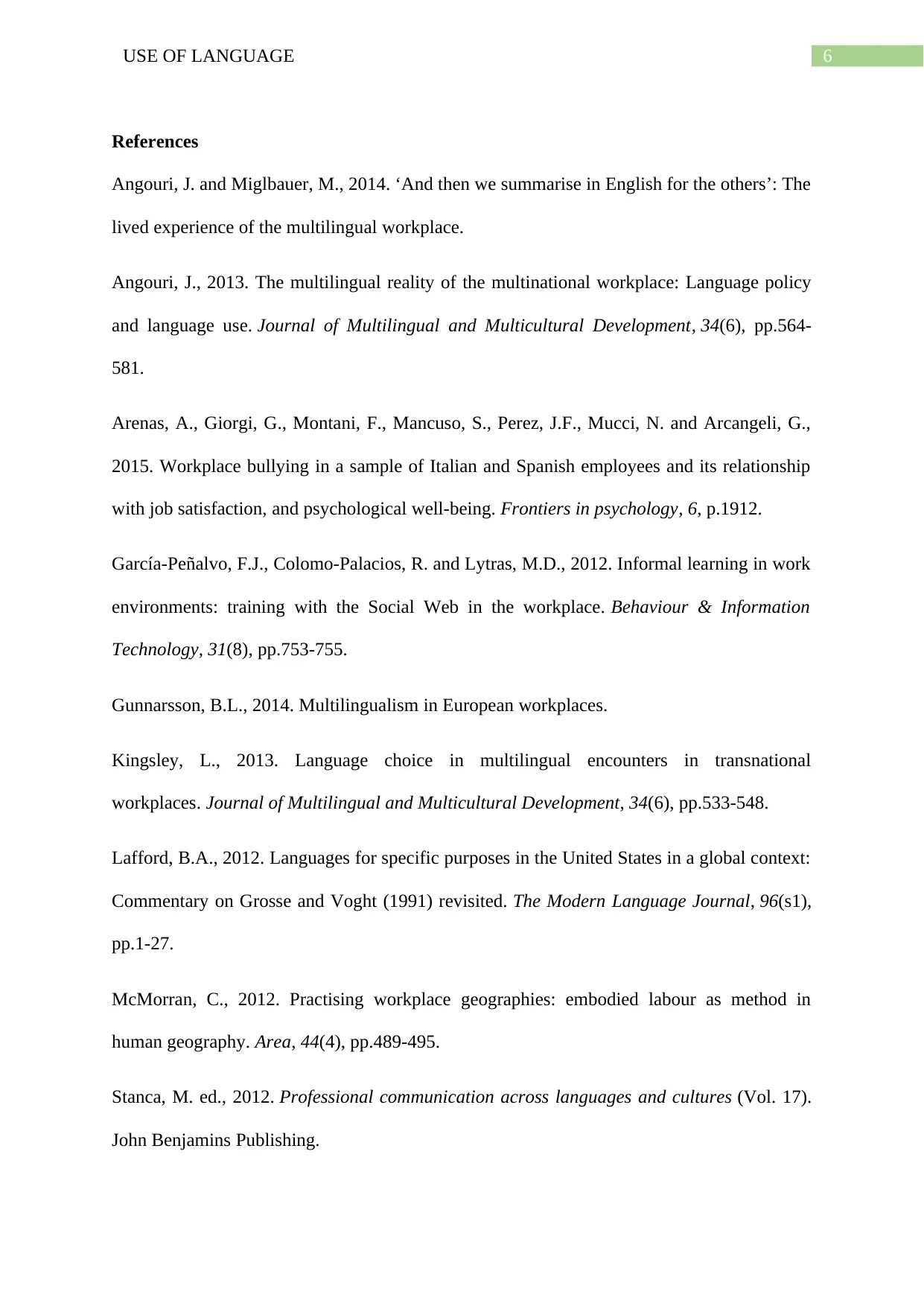
6USE OF LANGUAGE
References
Angouri, J. and Miglbauer, M., 2014. ‘And then we summarise in English for the others’: The
lived experience of the multilingual workplace.
Angouri, J., 2013. The multilingual reality of the multinational workplace: Language policy
and language use. Journal of Multilingual and Multicultural Development, 34(6), pp.564-
581.
Arenas, A., Giorgi, G., Montani, F., Mancuso, S., Perez, J.F., Mucci, N. and Arcangeli, G.,
2015. Workplace bullying in a sample of Italian and Spanish employees and its relationship
with job satisfaction, and psychological well-being. Frontiers in psychology, 6, p.1912.
García-Peñalvo, F.J., Colomo-Palacios, R. and Lytras, M.D., 2012. Informal learning in work
environments: training with the Social Web in the workplace. Behaviour & Information
Technology, 31(8), pp.753-755.
Gunnarsson, B.L., 2014. Multilingualism in European workplaces.
Kingsley, L., 2013. Language choice in multilingual encounters in transnational
workplaces. Journal of Multilingual and Multicultural Development, 34(6), pp.533-548.
Lafford, B.A., 2012. Languages for specific purposes in the United States in a global context:
Commentary on Grosse and Voght (1991) revisited. The Modern Language Journal, 96(s1),
pp.1-27.
McMorran, C., 2012. Practising workplace geographies: embodied labour as method in
human geography. Area, 44(4), pp.489-495.
Stanca, M. ed., 2012. Professional communication across languages and cultures (Vol. 17).
John Benjamins Publishing.
References
Angouri, J. and Miglbauer, M., 2014. ‘And then we summarise in English for the others’: The
lived experience of the multilingual workplace.
Angouri, J., 2013. The multilingual reality of the multinational workplace: Language policy
and language use. Journal of Multilingual and Multicultural Development, 34(6), pp.564-
581.
Arenas, A., Giorgi, G., Montani, F., Mancuso, S., Perez, J.F., Mucci, N. and Arcangeli, G.,
2015. Workplace bullying in a sample of Italian and Spanish employees and its relationship
with job satisfaction, and psychological well-being. Frontiers in psychology, 6, p.1912.
García-Peñalvo, F.J., Colomo-Palacios, R. and Lytras, M.D., 2012. Informal learning in work
environments: training with the Social Web in the workplace. Behaviour & Information
Technology, 31(8), pp.753-755.
Gunnarsson, B.L., 2014. Multilingualism in European workplaces.
Kingsley, L., 2013. Language choice in multilingual encounters in transnational
workplaces. Journal of Multilingual and Multicultural Development, 34(6), pp.533-548.
Lafford, B.A., 2012. Languages for specific purposes in the United States in a global context:
Commentary on Grosse and Voght (1991) revisited. The Modern Language Journal, 96(s1),
pp.1-27.
McMorran, C., 2012. Practising workplace geographies: embodied labour as method in
human geography. Area, 44(4), pp.489-495.
Stanca, M. ed., 2012. Professional communication across languages and cultures (Vol. 17).
John Benjamins Publishing.
Paraphrase This Document
Need a fresh take? Get an instant paraphrase of this document with our AI Paraphraser
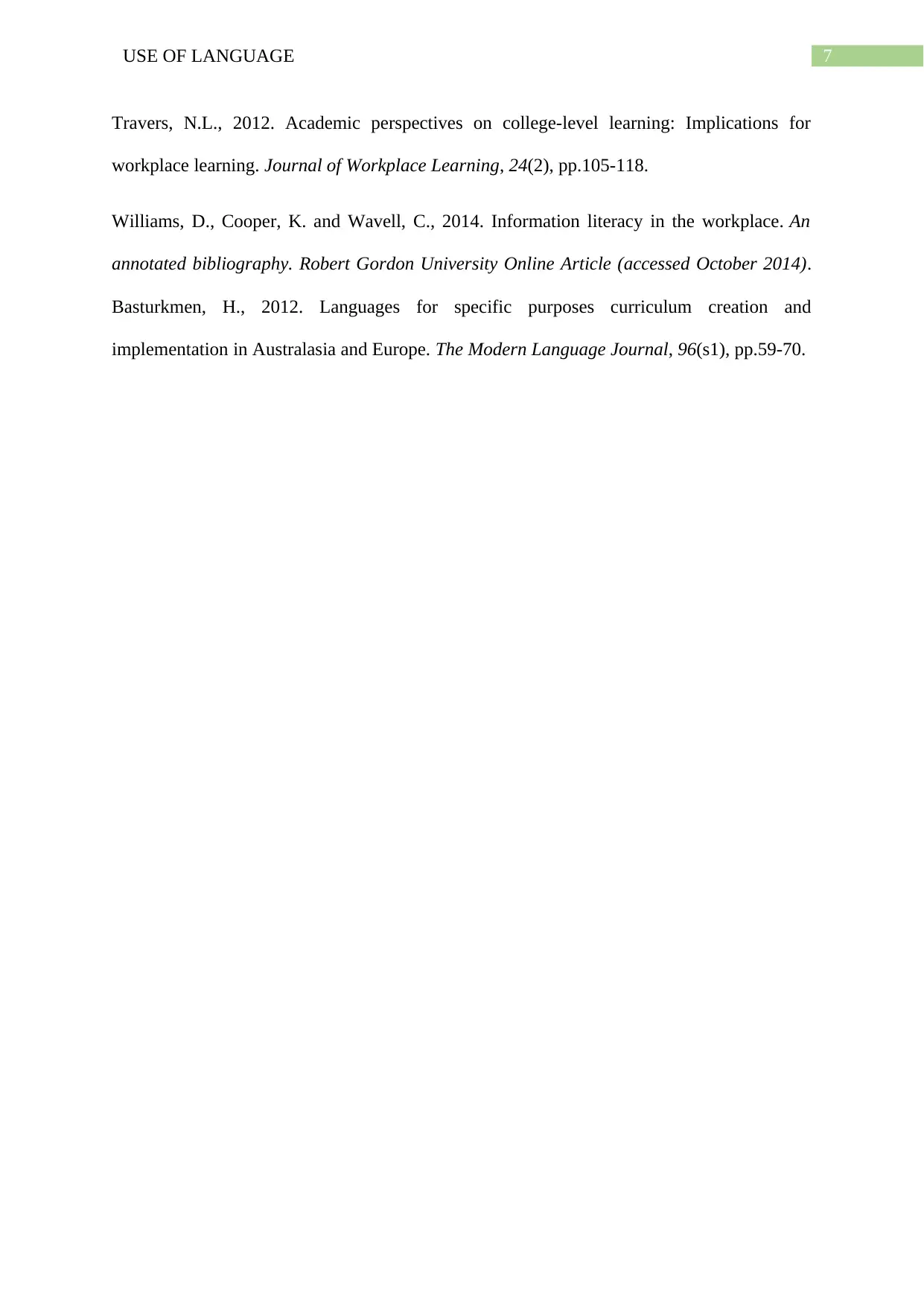
7USE OF LANGUAGE
Travers, N.L., 2012. Academic perspectives on college-level learning: Implications for
workplace learning. Journal of Workplace Learning, 24(2), pp.105-118.
Williams, D., Cooper, K. and Wavell, C., 2014. Information literacy in the workplace. An
annotated bibliography. Robert Gordon University Online Article (accessed October 2014).
Basturkmen, H., 2012. Languages for specific purposes curriculum creation and
implementation in Australasia and Europe. The Modern Language Journal, 96(s1), pp.59-70.
Travers, N.L., 2012. Academic perspectives on college-level learning: Implications for
workplace learning. Journal of Workplace Learning, 24(2), pp.105-118.
Williams, D., Cooper, K. and Wavell, C., 2014. Information literacy in the workplace. An
annotated bibliography. Robert Gordon University Online Article (accessed October 2014).
Basturkmen, H., 2012. Languages for specific purposes curriculum creation and
implementation in Australasia and Europe. The Modern Language Journal, 96(s1), pp.59-70.
1 out of 8
Related Documents
Your All-in-One AI-Powered Toolkit for Academic Success.
+13062052269
info@desklib.com
Available 24*7 on WhatsApp / Email
![[object Object]](/_next/static/media/star-bottom.7253800d.svg)
Unlock your academic potential
Copyright © 2020–2025 A2Z Services. All Rights Reserved. Developed and managed by ZUCOL.





